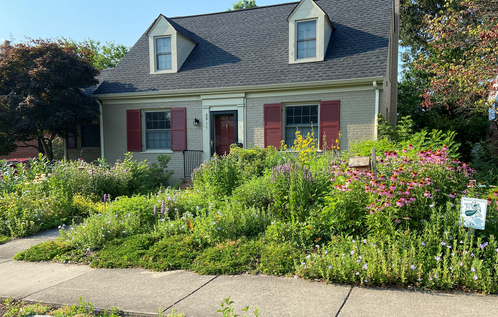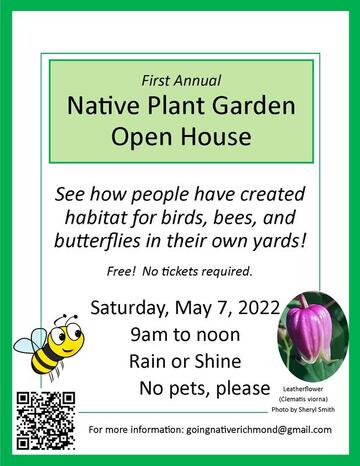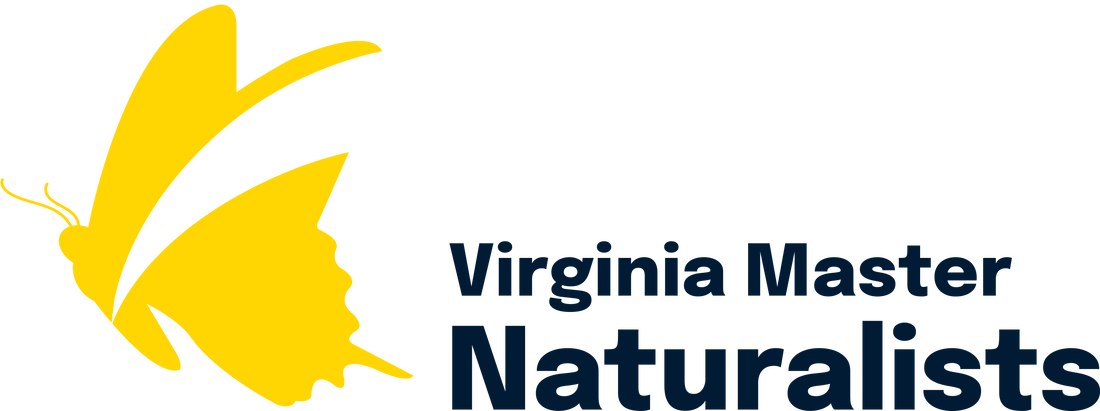 One of the native plant gardens on the tour. The tour description said, "This native plant/pollinator garden demonstrates that even a year of 0.2 acres can pack a punch for pollinators. The front yard has mostly sun loving prairie plants including wild petunia, golden Alexander, Columbine, royal catchfly, aromatic aster, three species of rudbeckia, wild Senna, and many more. The backyard has native shrubs including two viburnums, native pink azalea, native hydrangea, beautyberry, fragrant sumac, and more. There is something blooming from early spring to late fall!" Photo by Peg Mohar, VMN-Riverine Chapter.
One of the native plant gardens on the tour. The tour description said, "This native plant/pollinator garden demonstrates that even a year of 0.2 acres can pack a punch for pollinators. The front yard has mostly sun loving prairie plants including wild petunia, golden Alexander, Columbine, royal catchfly, aromatic aster, three species of rudbeckia, wild Senna, and many more. The backyard has native shrubs including two viburnums, native pink azalea, native hydrangea, beautyberry, fragrant sumac, and more. There is something blooming from early spring to late fall!" Photo by Peg Mohar, VMN-Riverine Chapter. --By Sheryl Smith, Riverine Chapter VMN
I was looking around at my yard on April 15th of this year, and thinking: “I’m ready. My native plant gardens have matured enough that I am ready to show them to people, and hopefully inspire them to plant more natives. I’m going to schedule an open house and see what happens.” I picked a date of Saturday, May 7th for the first annual Native Plant Garden Open House. I had no idea if people would be interested.
I posted the event in various places on Facebook, and emailed friends and family. I contacted local chapters of the VMN, Virginia Native Plant Society, and master gardeners. Suddenly, I had people I don’t even know saying, “Wow, I want to open up my gardens, too! Can I be a host?” I ended up having five host gardens. I made flyers with the addresses of each garden, the year the native garden was established, and brief descriptions. Part of an example description: “Paths curve through shady areas where woodland phlox, wild geranium, Jacob’s ladder, and bloodroot grow along with trillium and many ferns.”
The gardens were all far apart – none were closer than a 20 minute drive. None of us have mature gardens. Mine was the oldest, established in 2017. The weather forecast was gloomy, and on the day of the event it was about 60 degrees and drizzling. Would anyone come? Yes! I had 54 very enthusiastic people come during the 9am to noon open house. Some were fellow master naturalists, some were from the Virginia Native Plant Society. Some just heard about it somehow. Other than about 5 people, I had never met them before. People asked a lot of the same questions: “What is this plant?” “Where did you buy it?” and “Are you going to do this again next year? This is great! Please do it again!”
I was looking around at my yard on April 15th of this year, and thinking: “I’m ready. My native plant gardens have matured enough that I am ready to show them to people, and hopefully inspire them to plant more natives. I’m going to schedule an open house and see what happens.” I picked a date of Saturday, May 7th for the first annual Native Plant Garden Open House. I had no idea if people would be interested.
I posted the event in various places on Facebook, and emailed friends and family. I contacted local chapters of the VMN, Virginia Native Plant Society, and master gardeners. Suddenly, I had people I don’t even know saying, “Wow, I want to open up my gardens, too! Can I be a host?” I ended up having five host gardens. I made flyers with the addresses of each garden, the year the native garden was established, and brief descriptions. Part of an example description: “Paths curve through shady areas where woodland phlox, wild geranium, Jacob’s ladder, and bloodroot grow along with trillium and many ferns.”
The gardens were all far apart – none were closer than a 20 minute drive. None of us have mature gardens. Mine was the oldest, established in 2017. The weather forecast was gloomy, and on the day of the event it was about 60 degrees and drizzling. Would anyone come? Yes! I had 54 very enthusiastic people come during the 9am to noon open house. Some were fellow master naturalists, some were from the Virginia Native Plant Society. Some just heard about it somehow. Other than about 5 people, I had never met them before. People asked a lot of the same questions: “What is this plant?” “Where did you buy it?” and “Are you going to do this again next year? This is great! Please do it again!”
I already have 10 people who are interested in being hosts in 2023, and I haven’t advertised that I am looking for hosts. I have an email list with about 50 visitors who want to be notified about next year’s open house. This very last minute idea has been a success beyond my wildest dreams. Some people on Facebook who are outside the Richmond area are thinking of doing one in their area, too.
I’ve been learning about screening potential hosts. People who say “I think some of my plants are probably native” are not a good fit! I screen hosts by saying I want them to be able to identify the vast majority of the plants in their gardens, and to be able to say if they are native or non-native. If people have plants on the invasive species list in their yards, I am asking that they have a plan for removal, such as “We’re slowly decreasing this patch of English Ivy, and cutting it off the tree trunks.” So far, this has worked, and people have decided for themselves that they would not be right for it.
It has been a very rewarding experience for me and a lot of other people. It was really not much work, and my only cost was about $5.00 getting paper flyers printed. Each host set up their own open house. They decided whether to have ID signs for plants, educational flyers, free native plants, etc. I’m hoping this article inspires other VMNs to start their own native plant garden open houses!
I’ve been learning about screening potential hosts. People who say “I think some of my plants are probably native” are not a good fit! I screen hosts by saying I want them to be able to identify the vast majority of the plants in their gardens, and to be able to say if they are native or non-native. If people have plants on the invasive species list in their yards, I am asking that they have a plan for removal, such as “We’re slowly decreasing this patch of English Ivy, and cutting it off the tree trunks.” So far, this has worked, and people have decided for themselves that they would not be right for it.
It has been a very rewarding experience for me and a lot of other people. It was really not much work, and my only cost was about $5.00 getting paper flyers printed. Each host set up their own open house. They decided whether to have ID signs for plants, educational flyers, free native plants, etc. I’m hoping this article inspires other VMNs to start their own native plant garden open houses!

Another tour stop. Established in 2017, this partially wooded garden features over 150 species of native plants. Paths curve through shady areas where woodland phlox, wild geranium, Jacob's ladder, and bloodroot grow along with Trillium and many ferns. Native ground covers such as green and gold, dwarf crested iris, foamflower, and creeping phlox are used throughout the garden. There are many native shrubs, including sweet shrub, smooth and oak leaf hydrangea, and four species of viburnum. Erosion is being controlled at the street using river oats, obedient plant, mountain mint, and bee balm. There is a brand new small pond which has all native water plants. Photo by Sheryl Smith.



 RSS Feed
RSS Feed